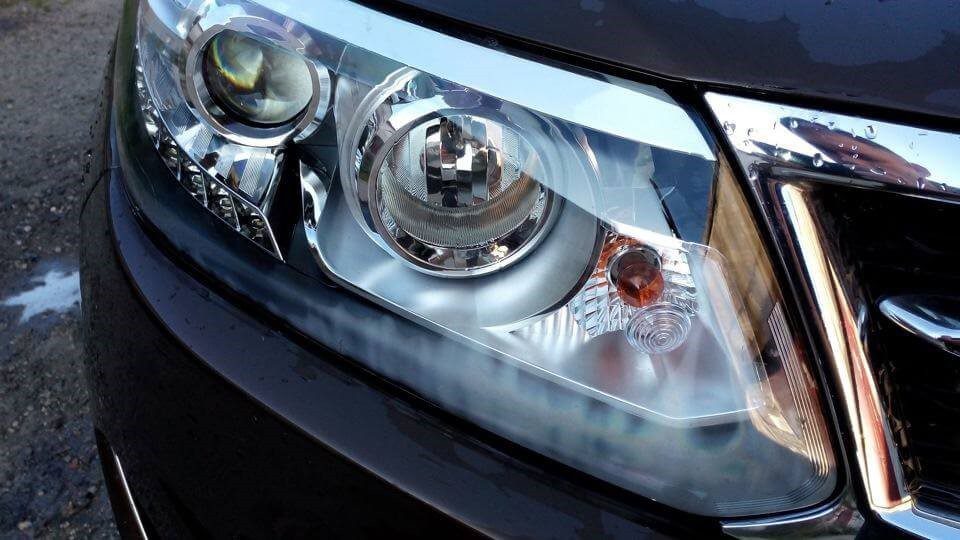
Causes and methods of fogging car headlights
Content
Headlights fogging from the inside is a common occurrence faced by motorists. Condensation often appears inside the optics after washing the vehicle or as a result of sudden changes in day and night temperatures. Many owners are oblivious to this phenomenon. However, the presence of water in lighting equipment is highly undesirable and even dangerous. Therefore, it is important to determine in a timely manner why the headlights are sweating, and to deal with the problem.
How condensation forms
Fogging of automotive optics is associated with the appearance of condensation inside the headlamp unit. Water, for various reasons, got inside, under the influence of heated lamps, begins to evaporate and settle in the form of drops on the inner surface of the headlight. The glass becomes more cloudy, and the light passing through it becomes dim and diffused. Water droplets act like a lens, changing the direction of light.
Fogging results in reduced visibility. This is especially dangerous at night or in poor visibility conditions.
Headlights fogging: causes of the problem
If the headlights on the car fog up regularly, this indicates an existing malfunction. In particular, this can be caused by:
- manufacturing defects;
- design feature of the car;
- violation of the tightness of the seams;
- damage resulting from an accident or during daily use.
However, among all other circumstances, there are three most common reasons for fogging optics.
Moisture ingress through the non-return valve
A non-return valve that regulates the pressure inside the optics is an indispensable element of every car headlight. While heated streams emanate from heated lamps and diodes, as it cools, cold air enters the optics through the check valve. Condensation forms inside the headlamp in high humidity.
To avoid fogging after washing, turn off the light a few minutes before starting work. The air inside the optics will have time to cool down, and condensation will not form.
Violation of the tightness of the joints
Long-term active operation of the car inevitably leads to a violation of the tightness of the seams and joints of the headlights. The sealant is thinned and damaged as a result of exposure to sunlight, constant shaking of the car while driving, and aggressive effects of road reagents. As a result, moisture enters the headlight through the leaky seams.
Headlamp integrity violation
Scratches, chips, and cracks on your lantern are another common cause of condensation. Damage to the headlight housing can occur both due to an accident, or in the case of an accidental hit of a small pebble that flew out from under the wheels of another car. Regardless of the circumstances, it is recommended to replace the damaged optics unit.
Consequences of fogging
The appearance of water in the headlamp unit is not as harmless as it might seem at first glance. Accumulating condensation can cause:
- rapid failure of lamps and diodes;
- premature wear of reflectors;
- oxidation of connectors and failure of the entire headlight;
- oxidation of wires and even short circuits.
In order to avoid all of the above problems, it is important to take timely measures to eliminate fogging.
How to fix the problem
To remove condensation from the inner surface of the headlight, it is enough to turn on the car optics. The heated air from the lamps will help the water evaporate. However, the moisture will not disappear anywhere and will still remain inside.
- To eliminate all the water from the inside, you will need to dismantle the headlamp unit. After disassembling it and removing the remaining moisture, all elements of the headlight should be thoroughly dried and then reassembled.
- If you don't want to shoot the entire block, you can use other methods. For example, after opening the lamp replacement cover, blow a hair dryer through the inner surface of the optics.
- Another way to eliminate moisture is to use silica gel bags, which are usually found in shoe boxes. Once the gel has absorbed all the moisture, the sachet can be removed.
These measures will only be a temporary solution to the problem. If you do not eliminate the original cause of fogging, then after a while condensation in the headlamp will reappear. The most effective way to eliminate condensation depends on the original problem.
Tightness of seams
If the reason for the appearance of condensation was the depressurization of the seams, they will have to be restored with a moisture-resistant sealant. Apply it to the damaged area and wait until the material is completely dry. In case of significant violations of the integrity of the joints, it is necessary to completely remove the old sealant and reapply the material. When it is completely dry, the headlight can be installed on the car.
Elimination of cracks
When fogging of the headlights occurs due to the appearance of small cracks in the optics housing, this disadvantage can be eliminated with the help of a leaky sealant. Before using it, the surface is degreased and allowed to dry completely.
The composition of the sealant has a transparent structure and high moisture-repellent properties. The material effectively fills the voids of chips and scratches.
By itself, the sealant transmits light beams well. However, the applied material can cause dust to build up, impairing the performance of the optics. Also, the composition has a not too long duration. Therefore, after a certain period of time, the problem with fogging may return again.
If there are significant cracks, chips and other damage on the headlamp housing, the optics must be replaced.
Sealing the internal space
If moisture enters the headlamp from the inside, sealing the interior will help get rid of the condensation. To carry out the work, you will have to dismantle the optics by disconnecting it from the car's electrical circuit. Inside, using special gaskets and sealing compounds, it is necessary to seal all holes, fasteners and gaps. With insufficient knowledge of automotive optics and electronics, it is recommended to entrust this process to car service specialists.
Condensation on the inside of a headlamp can lead to a wide variety of consequences, ranging from rapid burnout of lamps to short circuits. Misted headlights significantly reduce the quality of the light output. And insufficient illumination of the roadway when driving in the dark can lead to an emergency. Therefore, having determined the cause of fogging, it is necessary to eliminate the malfunction or replace the entire part as a whole.

